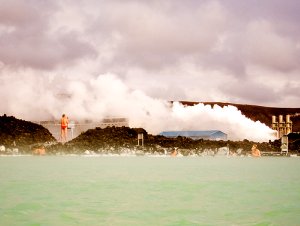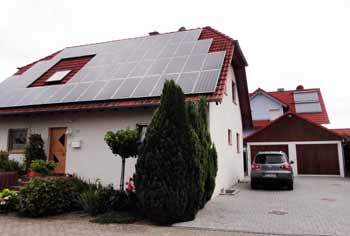How Does Geothermal Heating Work?
Have you ever asked yourself "How does geothermal heating work?" Here is a short article which gives an outline answer - without too many technical terms to confuse us!
There's also a brief look at the production of electricity from geothermal heat.

Geothermal heating in use in Iceland. You can just see the heating plant behind the steam from the heated pool.
- picture thanks to David.nikonvscanon on Flickr
How does geothermal heating work:
What is geothermal energy?
Geothermal energy is energy from the earth’s own store of heat. It comes in many different guises, from energy held in the earth just below our feet, to energy from deep in the earth – even molten rock.
Geothermal energy is believed to be sustainable and clean and it generally does not result in much by way of transportation costs and the resulting emissions.
How can we access geothermal energy for heating our homes?
The most practical methods for ordinary householders involve tapping into the stored heat that exists in rocks and soil not far down below our homes. The extraordinary fact is that the ground just a few feet down maintains a fairly steady temperature of between 10 to 16 degrees Celsius (between 50 and 60 degrees Fahrenheit). This is true around the inhabited world. This heat can be extracted and used to heat or cool homes.
Of course, most people would be unhappy with a kitchen that had an ambient temperature of just 12°C! The geothermal heat is fed into a heat pump which carries the warmth to a heat exchanger. The heat exchanger then gives up the heat to a system of indoor ducts which release the warmed air into the house.
The neat thing about this is that in the summer when air temperatures can soar, the reverse process can ensure a cool and comfortable home.
How does geothermal heating work:
The main types of geothermal energy for homes
Gethermal energy from the ground just below us is mainly exploited in two ways; closed loop and open loop systems.
Open loop systems rely on nearby groundwater (just below the surface) to supply the needed heat. This comes from the ambient temperature of the ground, which is reasonably stable all year around.
Open loop systems tend to be more suitable for larger buildings with heating and cooling demands of more than 100kW – usually offices and institutuions. The groundwater aquifers used for open loop systems need to be large enough to supply the demand – as well as other calls on their usage.
The British Geological Survey has produced maps and reports for areas of Britain, assessing the suitability for open loop systems.
Closed loop systems rely upon the temperature of the ground itself. Heat exchangers are placed in vertical bore holes or shallow horizontal trenches. Closed loop systems are more common in homes and smaller buildings. They tend to be relatively expensive to install compared to conventional systems.
How does geothermal heating work? In essence it can be very simple - if you are in the right place!
Hot springs and reservoirs
Hot springs have been in demand around the world for millennia, from pre-historic times. These natural springs occur where fissures in the earth’s crust give access to the hotter regions below the earth's crust. Such natural spas have been credited with explaining our love of hot bathing and have even used to explain our love of cooked foods; food brought into such an environment would undergo noticeable changes, akin to boiling or steaming.
Hot springs are great - if you are near them but most people are not.
However, there are also naturally occurring chambers below ground that store reservoirs of hot water. Again these are heated by proximity to magma or molten rock, sometimes from volcanoes. These hot water reservoirs can be exploited by drilling and the installation of machinery to control the flow of water. When towns are close to such natural resources it makes sense to use them for heating.
In the USA a lot of the western areas have access to geothermal heating. Several towns in Oregon use geothermal for heating homes and for industrial uses. Klamath Falls is one such town. There is potential for a lot more development of such resources; one study showed that California has seventy communities that could benefit from geothermal energy. Many other states have suitable areas where geothermal heating from hot water reservoirs, too.
Another way to exploit geothermal energy is by using it to generate electricity. This has a good deal of potential as a green and low carbon energy source. One way this is acheived is through engineered geothermal systems. Here's a brief look at how this works.
How does geothermal heating work:
Engineered geothermal systems (EGS)
Engineered geothermal systems promise relatively safe, clean electricity from engineering the rock in suitable subterranean areas to give up some of its heat.
Some exploitation can involve a kind of “fracking” i.e. fracturing rock at depths where high temperatures are found. This enables pressured cold water to be put in to the fractured rock areas. The water is recovered from a second bore hole, having gained heat from the heat exchange process, deep in the rock. The water is driven into areas of hot dry rock. This enables geothermal energy to be exploited in areas where there are no underground hot water reservoirs but there are areas of hot rock formations, usually composed of granite.
There are some problems that can occur with this approach, such as high resistance in the rock leading to the need for excessive pressure, or short-circuits developing in the fractured rocks.
The big difference between this and fracking as used in gas abstraction, is that fracking for gas involves a potent mix of toxic chemicals which can pollute nearby environments and water courses. The fracturing process also tends to be more drastic. Even so, fracturing rock can still have undesirable consequences.
One problem is induced seismic activity; Basel in Switzerland has cancelled a EGS project in 2009 because of this – the risks were just too great. Nevertheless, EGS is regarded as a great potential method of generating energy.
EGS is mainly used for electrity generation, rather than heating homes directly. There are examples around the world, including a 5000+ megawatt plant at Cooper Basin in Australia.
Cornwall in England has a lot of hot rock below the surface and a 3mW demonstration plant has been set up by the Eden Project.
Work is ongoing to develop EGS using CO2 as the medium for extracting heat. The idea is to sequestrate some of the carbon as part of the process and thereby keep it out of the atmosphere.
***
Sponsored links
An easy DIY option?
Installing a geothermal heating unit is not really a DIY option. So neither is it an easy home improvement project - except in so far as you give the responsibility to well-qualified professionals. Nevertheless, if you are starting a new build it is a worth a serious look. The long-term savings can be considerable and a well-constructed system should give years of service.
How Does Geothermal Heating Work? - TOP
Green Homes - Easy Home Improvement Projects
Greenfootsteps Home - for more easy green living ideas
How does geothermal heating work?
Copyright Greenfootsteps.com 2013.
Please do not copy without permission. This site is protected by Copyscape.
| Tweet |

| Tweet |

Sponsored links
On other pages

Sponsored advertising:
Footprints
- an occasional e-zine from Greenfootsteps
If you would like to receive the e-zine, please just sign up below.






New! Comments
Have your say about what you just read! Leave me a comment in the box below.